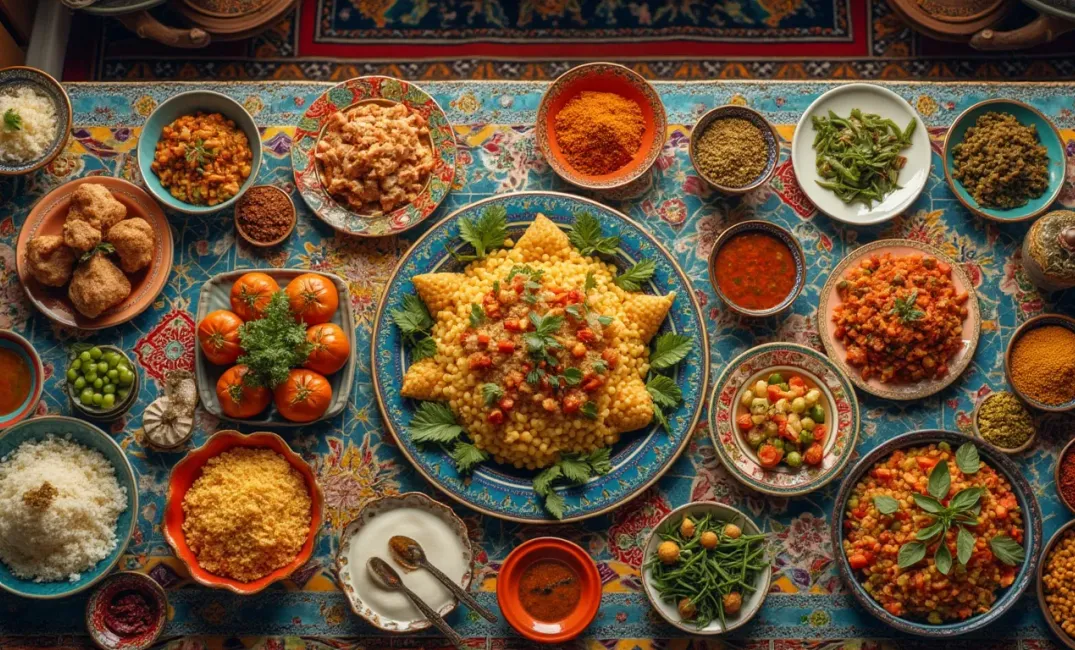Introduction: The Cuisine as Cultural Canvas
"Tell me what you eat, and I will tell you what you are." — Jean Anthelme Brillat-Savarin
Human cuisine, a tapestry of flavors, techniques, and traditions, is a profound expression of culture, identity, and innovation. Across time and space, culinary practices have evolved, reflecting the abundance of regional ingredients, the creativity of ancestral chefs, and the influence of external trades and migrations. This entry explores the symphony of human cuisine, examining its impact on society and identity, the artistry it embodies, and the vital role it plays in connecting communities across the globe.
The Early Roots of Culinary Practices
Foraging: The Original Culinary Venture
- The Hunter-Gatherer Diet: Early humans, who existed as hunter-gatherers, subsisted on a diverse diet that reflected native flora and fauna. Foraging for edible plants, nuts, fruits, roots, and hunting game formed the cornerstone of early culinary exploration.
- Discovery of Cooking: The mastery of fire transformed human diets, introducing warmth and flavor to previously raw foods. Cooking not only made food more palatable and digestible but also contributed to social and cultural activities, such as feasting, storytelling, and ritualistic gatherings.
Agriculture and the Birth of Culinary Foundations
- Agricultural Revolution: The advent of agriculture, with the domestication of grains, legumes, and animals, led to an increasingly settled way of life. This allowed for the development of stable food sources and gave rise to cuisines that revolved around staple crops such as wheat, rice, maize, and millet.
- Culinary Traditions Begin: As societies refined their agricultural practices, regional culinary traditions began to emerge, rooted in the availability and variety of locally cultivated ingredients. Culinary identities began to form, with variations shaped by geography, climate, and cultural exchange.
The Evolution of Global Flavors
Influences of Trade and Exploration
- The Spice Routes and Culinary Exchange: The ancient spice routes facilitated not only the trade of precious spices such as cinnamon, pepper, and clove but also cultural encounters that introduced new ingredients, techniques, and flavors to distant lands. The resultant fusion enriched global culinary traditions.
- Exploration's Culinary Impact: European exploration brought the Columbian Exchange, a period of extensive cultural and culinary interchange. New World ingredients like tomatoes, potatoes, and chocolate transformed Old World cuisines, while Old World grains and livestock became staples in the Americas.
Colonialism and Culinary Hybridity
- Colonial Culinary Creations: The colonial era prompted migrations that resulted in a mingling of culinary practices. Colonizers and indigenous populations influenced each other's traditions, giving rise to hybrid cuisines that blended ingredients, spices, and cooking methods from multiple cultures.
- Cultural Synthesis and Innovation: Regions under colonial rule often saw a synthesis of traditional and introduced cuisines, fostering culinary creativity and innovation. This blending of flavors is evident in dishes such as Caribbean jerk, Indian curry, and Vietnamese banh mi.
Artistic Culinary Expressions
Gastronomy as a Cultural Art Form
- The Art of Presentation: As culinary arts advanced, presentation became an essential component of gastronomy. Techniques such as plating, garnish, and arrangement elevated meals into a visual and sensory experience, often reflective of cultural aesthetics and philosophies.
- The Role of the Chef: Chefs have emerged as artists who blend taste, creativity, and tradition to create culinary masterpieces. Figures like Auguste Escoffier and Julia Child revolutionized culinary standards, fostering professional training that celebrated meticulous technique and innovation.
Innovations and Modern Trends
- Molecular Gastronomy: Cutting-edge techniques such as molecular gastronomy challenge traditional perceptions of food preparation and consumption. By investigating the science behind cooking processes, chefs craft innovative dishes that defy conventional textures and flavors.
- Sustainable and Ethical Cooking: Modern culinary trends increasingly focus on sustainability and ethical sourcing, aiming to minimize food waste and reduce environmental impact. Approaches like nose-to-tail and farm-to-table emphasize mindful consumption and respect for resources.
Cuisine as Cultural Identity and Connection
Festivals and Rituals: Celebrating through Food
- Culinary Traditions in Celebrations: Food plays a pivotal role in cultural celebrations and ceremonies worldwide. Festive dishes are often imbued with symbolic meanings and reflect cultural values and narratives, offering a taste of tradition to new generations.
- The Communal Table: Sharing meals fosters bonds and mutual understanding, transcending boundaries of language and geography. Communal dining experiences strengthen familial and social ties, offering a space where cultural heritage is shared, preserved, and celebrated.
Food as a Medium of Sociopolitical Expression
- Culinary Diplomacy and Soft Power: Nations often use cuisine as a tool for soft diplomacy, showcasing traditional dishes to foster goodwill and understanding. Food heritage events and culinary exchanges serve as cultural ambassadors on the global stage.
- The Politics of Plate: The agricultural and distributional aspects of food production intersect with socioeconomic and political issues, including food sovereignty, rights, and security. Advocacy for just and sustainable food systems has become a central concern in global discourse.
Culinary Resilience and Adaptability
Innovation in the Face of Adversity
- Adaptation in Crisis: History has documented the resilience of culinary traditions during times of scarcity and hardship. Communities adapt recipes and resource-use to survive, preserving tradition while innovating within constraints.
- Revival of Heritage Cuisines: Efforts to revive and sustain heritage cuisines arise as communities seek to preserve cultural history in the face of globalization. These movements strive to restore and celebrate traditional agricultural practices, unique flavors, and ancestral cooking methods.
The Future of Food: Reinventing Cuisine
- Tech-Savvy and Future Foods: The incorporation of technology in food production, such as lab-grown meats and vertical farming, signals a shift toward reinventing sustainable protein sources and addressing food security and climate impacts.
- Culinary Innovations and Nutrition: Scientific advancement and culinary experimentation continue to forge novel pathways in understanding the intersection of nutrition and gastronomy, exploring personalized diets and approaches to healthful eating.
Conclusion: The Enduring Legacy of Human Cuisine
"Food is our common ground, a universal experience." — James Beard
The symphony of human cuisine serves as a universal canvas that illustrates our interconnectedness and cultural diversity. As an enduring legacy, cuisine nourishes more than the body; it feeds the soul, fosters community, and celebrates the kaleidoscope of human identity. Reflecting histories of exchange, creativity, and resilience, the tapestry woven by culinary traditions is both vibrant and profound.
Cuisine will remain a cornerstone of cultural identity in an ever-interconnected world, guiding humanity's journey across time and space. Through the artistry of flavors, the shared experiences of meals, and the timeless act of breaking bread, our culinary heritage sustains and flourishes, inviting future generations to partake in its perpetual narrative.
As custodians of this legacy, we celebrate the shared table of humanity, where each dish is a story, every meal a connection, marked by an endless pursuit of taste, tradition, and togetherness. Let this rich culinary odyssey guide us in crafting a future where culture, creativity, and compassion converge on the vibrant palette of human experience.
CULINARY TRADITIONS, GASTRONOMY, GLOBAL FLAVORS, CULTURE, CULINARY INNOVATION, FOOD RESILIENCE, CULINARY ART, CUISINE, FOOD DIPLOMACY, CULTURAL IDENTITY

